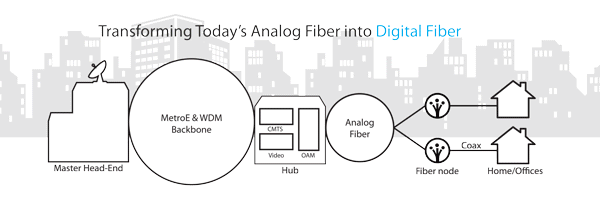As the cable industry prepares to transition towards distributed access architectures utilizing the CableLabs Remote PHY standard, it’s starting to see the many benefits that RPHY can bring.
One of those key benefits is around simplifying the network, which is the focus of this blog.
Today there is a legacy analog optical network that all cable operators/MSO’s have in place to service their optical nodes feeding the coaxial networks.

In the future, the connection between the CMTS core and the Remote PHY Device (RPD), the Converged Interconnect Network (CIN) according to CableLabs definition, becomes standardized, cost-efficient, simple and fast “plain old” Ethernet.
It is this CIN that provides a huge potential, an Ethernet network that has access to millions of subscribers and businesses, with a very high coverage in most of the worldwide population and business centers. This optical network historically has only been used for Cable TV and DOCSIS services.
Do you see the potential opportunity here?
What if this network can be unlocked allowing cable companies to offer access to both residential and business subscribers, with multiple services on top of it? DOCSIS, Ethernet, PON, WIFI or 5G – the physical transport becomes irrelevant, it is the service on top that matters. Yet, with that many different services on a network, the complexities of managing QoS and QoE increases dramatically.
Enter Segment Routing. Cisco is working towards providing full-fledged Segment Routing (SR) capabilities in this CIN, enabling network slicing and simplified traffic engineering. Standards-based SR removes the complexity out of multi-service networks – delivering on our commitment to the industry to simplify operations yet increasing the capability to differentiate services to ensure QoE and QoS. These services could include:
- Business services:
- DOCSIS
- PON
- ETTB
- Wireless
- Residential services:
- DOCSIS
- ETTH
- PON
- Wireless
- WIFI Hotspots and Access points, including IoT access
- Open Access
- 4G and 5G backhaul
- PON based services with OLT’s embedded in the RPHY enabled Optical Node or remote device
What are the other drivers for SR in cable networks? Next to the CIN use case, we are also implementing SR in order to drive traffic separation in the core, such as for multicast streams. Transitioning from MPLS-VPN and MPLS-TE towards Segment Routing.
More details on that use case in a future blog!

Very good article piece. I surely appreciate this website. Keep writing!
http://wwwcenturionwealth.com/
Very nice post. I definitely like your site. Stick with it!
http://www.investopedia.com/advisor-network/advisors/61757/wendy-ann-payne-csa-cep-/
Very nice article piece. I absolutely love this site . Continue the good work!
An fascinating discussion is worth comment. I think that you should write extra on this subject, it may not be a taboo subject but usually individuals are not sufficient to speak on such topics. To the next. Cheers
http://salonandspacommunity.com/blogs/3015/19568/a-nice-long-lasting-solution-in
Excellent goods from you, man. I’ve take note your stuff previous to and you’re simply too wonderful. I actually like what you have bought right here, really like what you are saying and the best way through which you assert it. You make it enjoyable and you still care for to stay it sensible. I cant wait to read much more from you. That is really a wonderful website.
http://www.buloobaby.com/blog/24390/management-consultants-tips/